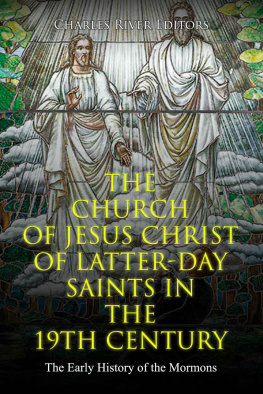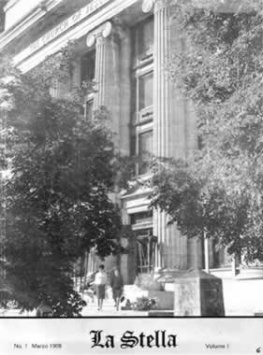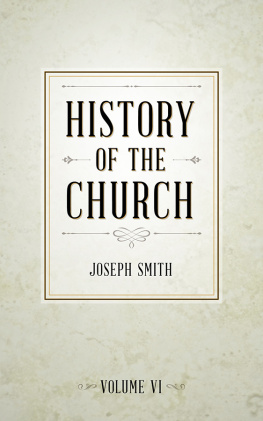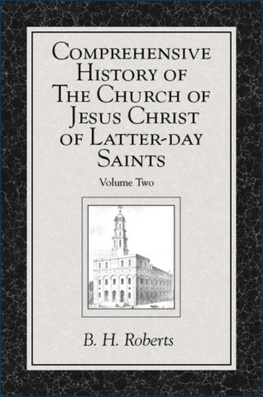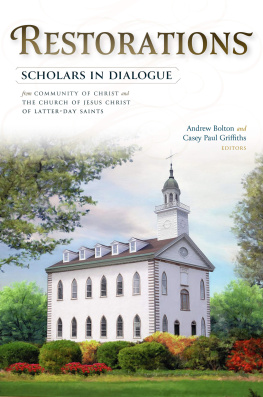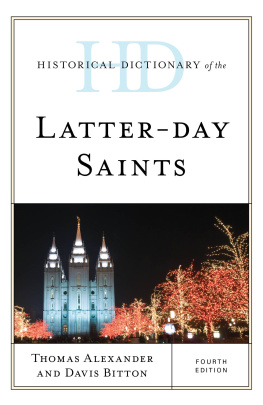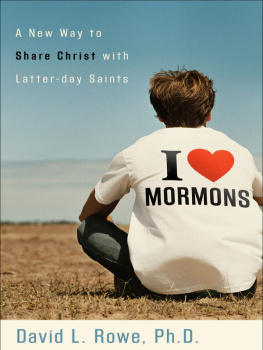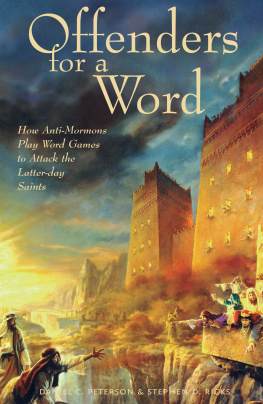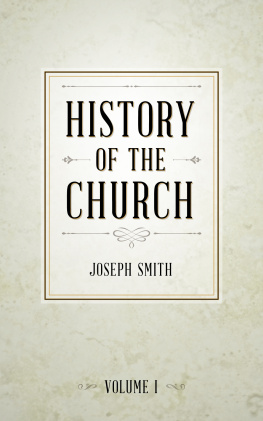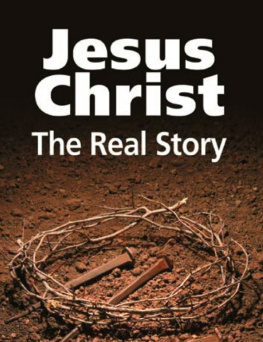Charles River Editors - The Church of Jesus Christ of Latter-day Saints in the 19th Century: The Early History of the Mormons
Here you can read online Charles River Editors - The Church of Jesus Christ of Latter-day Saints in the 19th Century: The Early History of the Mormons full text of the book (entire story) in english for free. Download pdf and epub, get meaning, cover and reviews about this ebook. year: 2020, publisher: Charles River Editors, genre: Art. Description of the work, (preface) as well as reviews are available. Best literature library LitArk.com created for fans of good reading and offers a wide selection of genres:
Romance novel
Science fiction
Adventure
Detective
Science
History
Home and family
Prose
Art
Politics
Computer
Non-fiction
Religion
Business
Children
Humor
Choose a favorite category and find really read worthwhile books. Enjoy immersion in the world of imagination, feel the emotions of the characters or learn something new for yourself, make an fascinating discovery.
- Book:The Church of Jesus Christ of Latter-day Saints in the 19th Century: The Early History of the Mormons
- Author:
- Publisher:Charles River Editors
- Genre:
- Year:2020
- Rating:3 / 5
- Favourites:Add to favourites
- Your mark:
- 60
- 1
- 2
- 3
- 4
- 5
The Church of Jesus Christ of Latter-day Saints in the 19th Century: The Early History of the Mormons: summary, description and annotation
We offer to read an annotation, description, summary or preface (depends on what the author of the book "The Church of Jesus Christ of Latter-day Saints in the 19th Century: The Early History of the Mormons" wrote himself). If you haven't found the necessary information about the book — write in the comments, we will try to find it.
The Church of Jesus Christ of Latter-day Saints in the 19th Century: The Early History of the Mormons — read online for free the complete book (whole text) full work
Below is the text of the book, divided by pages. System saving the place of the last page read, allows you to conveniently read the book "The Church of Jesus Christ of Latter-day Saints in the 19th Century: The Early History of the Mormons" online for free, without having to search again every time where you left off. Put a bookmark, and you can go to the page where you finished reading at any time.
Font size:
Interval:
Bookmark:
By Charles River Editors
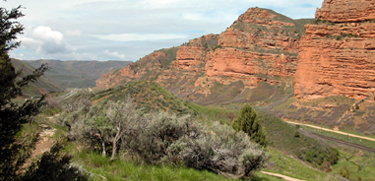
A picture of Echo Canyon on the Mormon Trail

Charles River Editors is a boutique digital publishing company, specializing in bringing history back to life with educational and engaging books on a wide range of topics. Keep up to date with our new and free offerings with this 5 second sign up on our weekly mailing list , and visit Our Kindle Author Page to see other recently published Kindle titles.
We make these books for you and always want to know our readers opinions, so we encourage you to leave reviews and look forward to publishing new and exciting titles each week.

Joseph Smith
Our missionaries are going forth to different nations, and in Germany, Palestine, New Holland, the East Indies, and other places, the standard of truth has been erected: no unhallowed hand can stop the work from progressing, persecutions may rage, mobs may combine, armies may assemble, calumny may defame, but the truth of God will go forth boldly, nobly, and independent till it has penetrated every continent, visited every clime, swept every country, and sounded in every ear, till the purposes of God shall be accomplished and the great Jehovah shall say the work is done. Joseph Smith
Among all the various figures in 19th century America who left controversial legacies, it is hard to find one as influential as Joseph Smith (1805-1844), the founder of The Church of Jesus Christ of Latter-Day Saints, Mormonism, and the Latter-Day Saint movement. Revered as a prophet on the level of Moses by some, reviled as a perpetrator of large-scale fraud by others, what everyone can agree on is that Joseph Smith founded a religious movement that played a crucial role in the settlement of the West, especially in Utah.
Locating Joseph Smith in history is to look for the "mess" of early America and find him standing in the middle, trying to make sense of the "native pandemonium" that gripped the nation in its formative years. All the things that Mormons recoil at - the mention of his treasure seeking days of youth, the use of the seer stones and looking into the hat to read "reformed Egyptian" - help explain the youthful creativeness of a young United States trying to organize itself. There is a humor in his story, and especially those first years of creating the Church that speak directly anyone who has felt the exhilaration of creativity. Inspired by the Second Great Awakening and evidence of Native American cultures that surrounded him during his early years in western New York, Smith claimed that he had visions as a young adult that helped him produce the Book of Mormon, and he was able to create a society of like-minded followers who intended to strike west and found Zion.
Smiths dream of Zion would lead the way for the trials and the tribulations of the Mormons for the rest of the 19th century, including countless conflicts with local authorities and the U.S. government. Smith himself would be a casualty of the clashing, murdered by a mob in 1844 after being imprisoned in Carthage, Illinois near the settlement of Nauvoo, which Smith had painstakingly tried to create as a commune for his people.
Among the most effective methods by which the Latter-Day Saints attained regional dominance was the flooding of specific areas with a like-minded population of fellow settlers and offspring, subsequently controlling the voting and government institutions through a weighty majority. Such an approach caused alarm in each region to which Mormon settlers emigrated; the church collective had already been evicted from New York and other areas for exercising the tactic. The practice of polygamy within the church may have been socially repugnant to Judaic and Christian denominations, but the schism between Mormonism and other American faiths lay deeper in the Restoration of the Priesthood. This core tenet of the church was based on a non-negotiable belief that Christs disciples died before they were able to pass on their masters authority in the process of Apostolic Succession. Therefore, what came after, whether Catholic or Protestant, was based on an absence of authority, leaving the Mormon faith to stand alone as the one true church.
This theological separatism caused the Mormon community to live apart, except in the pursuit of converts. The church became increasingly perceived as un-American, and over time hostile to and dismissive of those living outside the faith. In time, the Mormon belief that its members were the only heirs to the kingdom of God justified the commission of crimes, including murder. The non-Mormon population responded in kind, following a policy of extermination and setting the scene for violent conflicts across the frontier over several decades.
Smiths death was one of the catalysts for the Mormons great migration to Utah, and today that state and the Mormons are virtually synonymous. To this day, Mormons still form a majority of the population, and members of the Church have prominent political and economic roles. Both of Utahs U.S. Senators, Mike Lee and Mitt Romney, are Mormons, as is Governor Gary Herbert. The story of the Mormon pioneers and the trail they trod is one of the great stories of the westward expansion of the United States. Frenchman Hyppolite Taine wrote of the migration in romantic terms in the 1860s: Since the exodus of the Israelites there is no example of so great a religious emigration executed across such great spaces in spite of such obstacles, by so great a number of men, with so much order, obedience, courage, patience, and devotionBut the mainsprings of this great will was faith. Without it men would not have done such things. These exiles thought that they were founding the city of God, the metropolis of mankind. They considered themselves the renovators of the world. Let us remember our youth, and with what force an idea...merely by the fact that it seems good and true to us hurls us forward despite natural egotism, daily weakness, habits that we have contracted, surrounding prejudices, and accumulated obstacles! We dont know of what we are capable.
Stanley Kimball pointed out the curious fact that the Mormons, who did not want to go west in the first place, were among the most successful in doing so. He noted, Mormons, in as much as they did not go west for a new identity, missionary work, adventure, furs, land, health, or gold, but were driven beyond the frontier for their religious beliefs, were not typical westering Americans. While their trail experience was similar to other westering Americans, their motivation was different. It hardly seems necessary to document such a well known fact, but it will be helpful, in this respect, to refer to the city of Nauvoo, Illinois, itself. It was not a typical frontier community, nor did it resemble other frontier communities peopled by those pushing west. Nauvoo, rather, resembled an established New England city. It contained the many brick and substantial frame homes of people intending to remain, not the temporary log cabins of people on the move. The pioneer group was not concerned with just getting themselves safely settled, but with making the road easier for others of their faith to follow. Furthermore, the Mormons moved as villages on wheels, transplanting an entire people, rather than isolated, unrelated groups as was the case with the Oregon and California migrations...Not only did the Mormons not want to go west, but they were generally much poorer than the average California or Oregon migrants. Mormons used no professional guides, but they did consult many contemporary guidebooks, reports, and maps. Furthermore, many Saints were not rugged frontier types who had come from pioneering stock. Most, especially the European urban converts, had little experience with rural life at all ; they traveled generally as families, not as individuals ; the Mormon Trail was a two - way road, hundreds - - missionaries, "go backs," or disenchanted Mormons, and Church wagon trains hauling emigrants from the Missouri River - - traveled eastward on the trail. Mormons were conditioned by religious convictions; they followed a chain of command, maintained organized groups and trail discipline. Consequently, the Mormons are generally considered to have been some of the most systematic, organized, and disciplined pioneers and colonizers in United States ' history.
Font size:
Interval:
Bookmark:
Similar books «The Church of Jesus Christ of Latter-day Saints in the 19th Century: The Early History of the Mormons»
Look at similar books to The Church of Jesus Christ of Latter-day Saints in the 19th Century: The Early History of the Mormons. We have selected literature similar in name and meaning in the hope of providing readers with more options to find new, interesting, not yet read works.
Discussion, reviews of the book The Church of Jesus Christ of Latter-day Saints in the 19th Century: The Early History of the Mormons and just readers' own opinions. Leave your comments, write what you think about the work, its meaning or the main characters. Specify what exactly you liked and what you didn't like, and why you think so.

